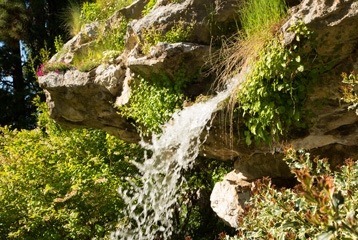Did you know? The jet d'eau was born in the Coulouvrenière hydraulic factory, the Place du Molard was a port and the Parc des Eaux-Vives was an amusement park...
The Bourg-de-Four and the housing crisis in the 17th century
If you look closely at the houses lining the Bourg-de-Four, you will notice that some are raised from the ground. In the 17th century, Protestant refugees were flooding into the city. As the city was becoming too crowded inside its walls, people had the idea of adding storeys to the buildings.
Raucous electoral evenings
The first electoral building, erected in 1855 where the current Uni Dufour building stands, was called the Boîte à gifles (slapping box). That gives you an idea of the atmosphere during debates! As the only cantonal voting station, people travelled here from throughout the entire region. Demolished in 1914 then rebuilt, it burned to the ground in 1964.
Sissi’s assassin locked up in a former bishopric
During the Reformation, Bishop Pierre de la Baume fled the city. The episcopal palace was converted into a prison in 1535. The building was razed to the ground in 1840, but another prison was built in its place. This was where Luigi Lucheni, the man who assassinated Empress Sissi was locked up in 1910. He committed suicide in prison. The building was destroyed in 1940. All that was left were the walls bordering the Agrippa-d’Aubigné terrace and the name of the Rue de l’Evêché (bishopric street).
A port in the city
At the heart of the lower town, between the Rues Basses and the lake, the street names remind us that the waters of the lake could be heard up to the rue de la Croix d’Or. The Rue du Port refers to the former port of Longemalle. The Molard tower stood guard at the entrance to the port from as early as the 14th century. During the same period, the Molard wharf boasted a hall and began to host Geneva’s fairs, as the Bourg-de-Four had become too small.
An amusement park in les Eaux-Vives
The Parc des Eaux-Vives was private property until 1898. It was then turned into an amusement park with a theatre, slide, miniature train, menagerie, aircraft displays and other entertainment. In 1913, the municipality bought the park after the amusement park went bankrupt.
Rousseau’s books burned in front of the city hall
Today, Jean-Jacques Rousseau is held in great esteem in the city of his birth, as witnessed by the numerous events celebrating the tercentenary of his birth in 2012. ““The Rousseau affair” nevertheless showed that this was not always the case: in 1762, the government of Geneva sent the philosopher into exile because of his forward-thinking and subversive ideas in terms of education and politics. His works Emile and The Social Contract were burned in front of the city hall. The judgement was reversed in 1794, sixteen years after his death.
Water with therapeutic qualities among the springs of les Eaux-Vives
The name “Eaux-Vives” relates to a time in the district’s history when there were numerous springs and little streams in the area, providing the city with drinking water. These stream, called “nants", mostly flowed through pipes under the roads. They left some traces of their existence, such as the Rue du Nant and the Place de Jargonnant, which bears the name of the last stream to be used for domestic purposes.
One of the springs is still visible at the bottom of the Parc des Eaux-Vives in a small cave. In 1913, when the municipality completed the park, it hoped to market its water, known for its therapeutic qualities, under the name Source Marcis. Unfortunately, just before it bottling began, an analysis revealed the presence of harmful microbes.
Sources:
- Jean-Philippe Follet, Un grand week-end à Genève, Baume-les-Dames: Hachette, 2006
- Marcel Granger, Eaux-Vives, quartier de mémoire, Yens-sur-Morges, 2002
- Doris Keller (dir.), 100 ans de Bourg-de-Four: histoire vivante du siècle passé, Geneva, 2001
- André Klopmann and Marcel Malherbe, Genève Lumières, Geneva: Slatkine and Republic and canton of Geneva, 2005
- Christian Vellas and Gérard Chardonnens, Genève, Vieille-Ville, vieilles rues, Geneva, 1999
- Pernette Rickli-Gos and Béatrice Obergfell, Genève et ses mystères: flâneries insolites dans l'histoire, Yens-sur-Morges, 2007
Article modifié le 16.02.2021 à 12:14

